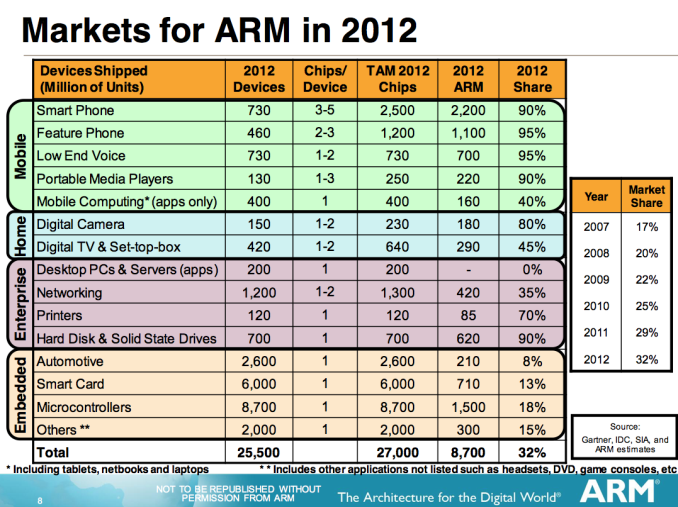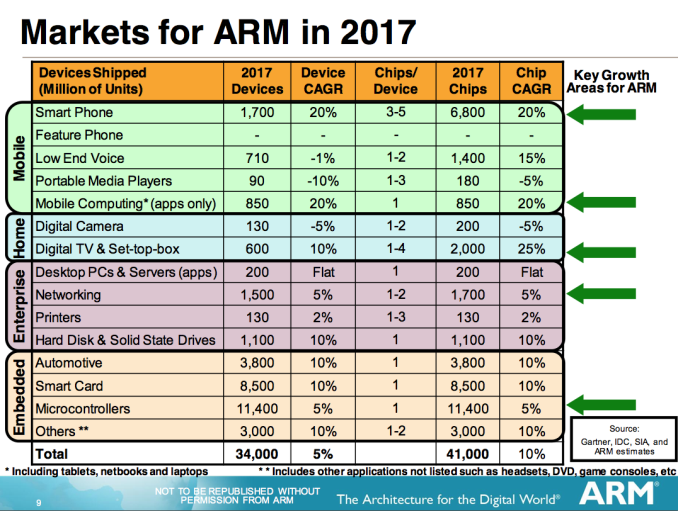The ARM Diaries, Part 1: How ARM’s Business Model Works
by Anand Lal Shimpi on June 28, 2013 12:06 AM ESTMarket Share
In 2012, ARM licensees shipped around 8.7 billion chips. Depending on the market segment, a single device can have anywhere from one to many ARM cores in it. Even looking within a smartphone you have multiple ARM cores not only within the apps processor but also inside the modem.
Although ARM has tremendous market share within the ultra mobile space (90%+), more than half of its shipments come from other segments. Enterprise, digital home, TVs, etc... are all expected to be drivers of growth for ARM in the coming years. By 2017 ARM expects its customers to be shipping roughly 41 billion chips that use ARM IP every year.
Final Words
Business models that leverage the scale and strength of a distributed production model are often very disruptive. ARM designs IP that can be implemented by fabless and fully integrated semiconductor companies very quickly, and at relatively low cost. No one member of the supply chain has to assume a significant amount of risk relative to others in the chain. It’s a far more democratic and partner centric approach to chip supply, which is one reason that it’s done so well.
ARM’s business allows for the creation and sustainability of several chip companies, which in turn keeps prices very low and prevents consolidation of power in any one firm. Although other factors (e.g. modem business, patent licensing) have lead to dominance in specific markets, ARM’s overall impact on the industry is one of promoting competition and keeping (silicon) prices low. ARM quite obviously enables what Qualcomm calls the Internet of things, where nearly everything is connected and computes.
It’s important to note that although our focus on ARM tends to be in the smartphone and tablet space, the majority of its licensed shipments come from other areas. It’s quite likely that ARM’s chances for future growth in terms of margin are in higher-end mobile SoCs, but competition from Intel in one segment surely won’t be the end of the world for ARM.
In the coming parts I’ll be taking a look at some of ARM’s newly announced microprocessor architectures such as the Cortex A12, A53 and A57. I’ll also be looking a little deeper into big.LITTLE and Mali graphics.












64 Comments
View All Comments
pluto7777 - Friday, June 28, 2013 - link
Exactly what is this IP they sell? Is it for hardware or software because Mali is a giant black box. Intel came to realize they could do more good for the end users by embracing open source. It's a shame this idea completely escapes ARM.ShieTar - Friday, June 28, 2013 - link
ARMs main IP is the processor design. Intel has absolutely no plans to make their Haswell-Designs open source. They also still sell their compiler and high performance libraries, so I really don't see how they are "embracing open source". Care to clarify your statement?Spunjji - Friday, June 28, 2013 - link
I'm fairly sure they're talking complete nonsense.name99 - Friday, June 28, 2013 - link
And it's not even Haswell's design. Intel produces a ton of software (like ICC and their math libs) which aren't open source...pluto7777 - Friday, June 28, 2013 - link
True, but it's evident Intel is at least trying. Even AMD has made some positive steps. Do yourselves a favor and look into Lima. ARM apparently doesn't like people reverse engineering their stuff.pluto7777 - Friday, June 28, 2013 - link
Intel has open source drivers on Linux. They actually employee people to work on this instead of other companies who only have closed source drivers and force other people to backwards engineer everything if they want an open driver.iwod - Friday, June 28, 2013 - link
Seeing both IMG ( MIPS ) and ARM are IP liscensing company, do both company's business mode work similary?And When will Anantech do a piece on the newly annoucned MIPS v5 "Warrior".
pluto7777 - Friday, June 28, 2013 - link
That's another true loss. I can't Imagine how anyone could want anything from Imagination Technologies. I hope they only get Microsoft support and don't try to leech off the open source community through some loophole like Android does.munsie - Friday, June 28, 2013 - link
I assume you mean the MIPS processor, not their GPUs? Because Apple has been shipping Imagination Tech GPUs since the first iPhone and Intel used them originally for their integrated graphics.ShieTar - Friday, June 28, 2013 - link
"In the PC industry, the concept of a fabless semiconductor isn’t unusual."And most chemistry labs also work with fabless semiconductors. I think this sentence is missing a word ;-)